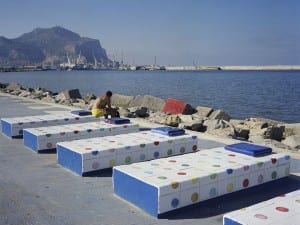Nature and the landscape are central themes throughout the photographic oeuvre of Elger Esser (b. 1967). Often using muted, sepia or monochromatic colours, his works have a stillness about them that evokes a sense of the sublime and the infinite.
Though he is primarily associated with large-format images of European lowlands with his characteristic low horizon lines, pale luminous colours and vast skies, Esser’s current focus is on the countries of the near East, and his new series Morgenland, was created during his travels in Lebanon, Egypt and Israel from 2004 to 2015. Showing for the first time at Parasol Unit, London, the Morgenland (“morning land”) title refers to the concept of the Orient. Rather than reflecting a negative stereotypical “Orientalism” with its links to cultural colonialism, as discussed by Edward Said in his 1978 book on the subject, Esser’s depictions aim to convey a sense of reconciliation amidst a political landscape of regional differences and historical conflicts. He presents a timeline of conflicts, dating from the Byzantine period to recent times, showing the development and decay of cultural periods. He sees landscapes as stratifications, layers upon layers of different cultures.
Travelling along the Lebanese shore in 2004 and the Nile between Luxor and Aswan in 2011, Esser photographed traditional feluccas and dahabiya sailing vessels, using an 8 x 10 Land camera. Captured from a great distance, the calm awe-inspiring landscapes are reminiscent of the romantic images of faraway lands on old postcards. Their quiet and serene beauty, however, is disturbing because it stands in stark contrast to what we know of the ugly conflicts taking place in the region. During a visit to Israel in 2015, Esser also created a series of works based on archival photographs taken by an unknown photographer who documented the existence of ruins in Israel/Palestine during 1948.
Esser’s skilful use of traditional processes, such as photogravure printing, gives his images an intense sharpness, depth and luminosity, and his approach is inspired by the literary works of Gustave Flaubert, Marcel Proust and Guy de Maupassant, the paintings of the Romantic period, and early nineteenth-century photography.
Elger Esser: Morgenland; Parasol Unit Foundation for Contemporary Art, London until 21 May. For more information: www.parasol-unit.org.
For the latest in contemporary arts and culture, follow us on Instagram, Twitter and Facebook.
Credits:
1. Elger Esser, One Sky I, (Liman, Tyre) Israel, 2015. Courtesy of the artist.





